Microeconomics Assignment: Solutions to All Questions and Answers
VerifiedAdded on 2020/04/21
|10
|838
|237
Homework Assignment
AI Summary
This document presents a comprehensive solution set for a microeconomics homework assignment. The answers cover a wide range of topics within microeconomics, including elasticity, supply and demand, consumer and producer surplus, and market equilibrium. The assignment includes multiple-choice questions addressing concepts such as price ceilings, market outcomes, tax burdens, and the impact of various economic scenarios. Each question is answered with the correct choice, and some answers are supported by explanations. The provided bibliography lists key microeconomics textbooks and resources used to support the answers. This resource is designed to help students understand and master microeconomic principles.
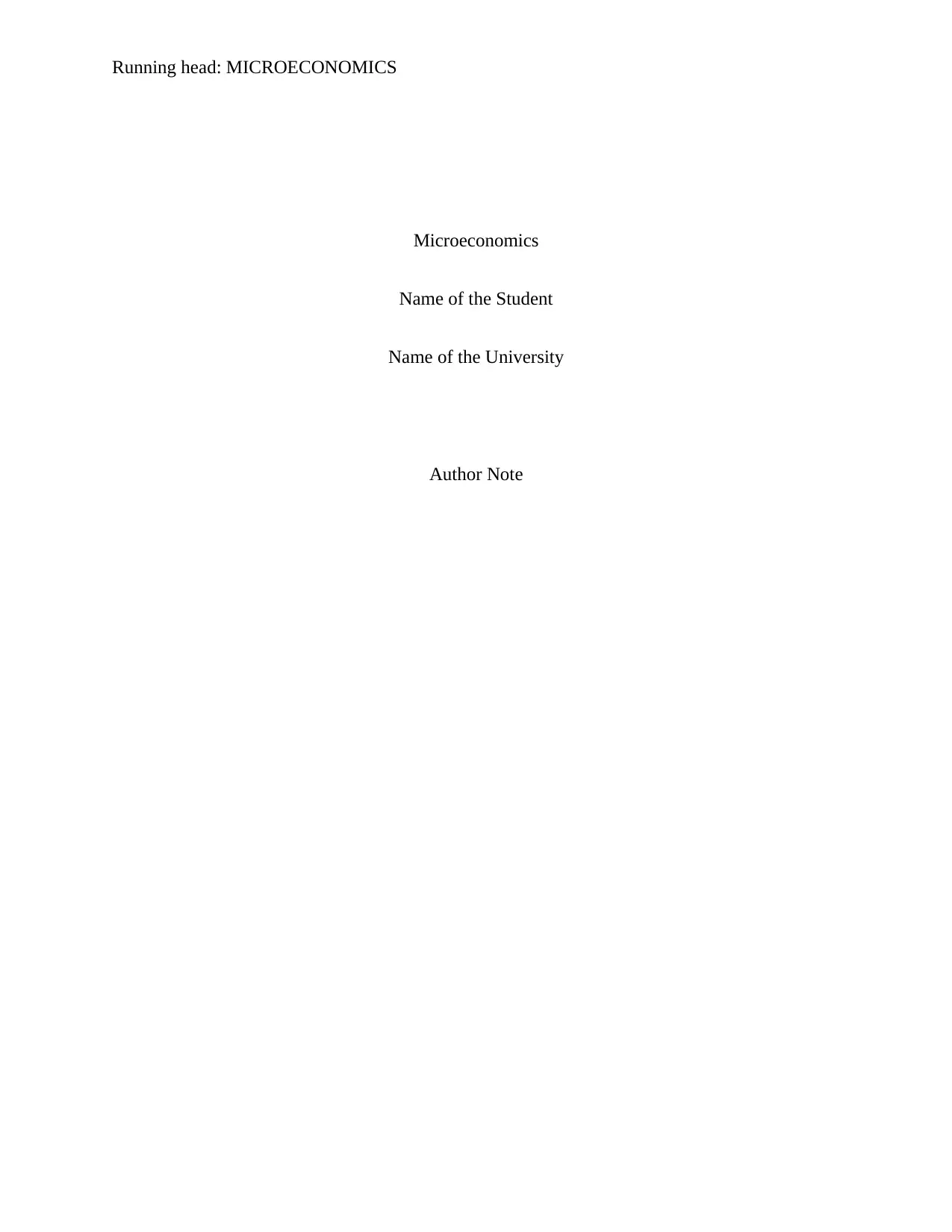
Running head: MICROECONOMICS
Microeconomics
Name of the Student
Name of the University
Author Note
Microeconomics
Name of the Student
Name of the University
Author Note
Paraphrase This Document
Need a fresh take? Get an instant paraphrase of this document with our AI Paraphraser
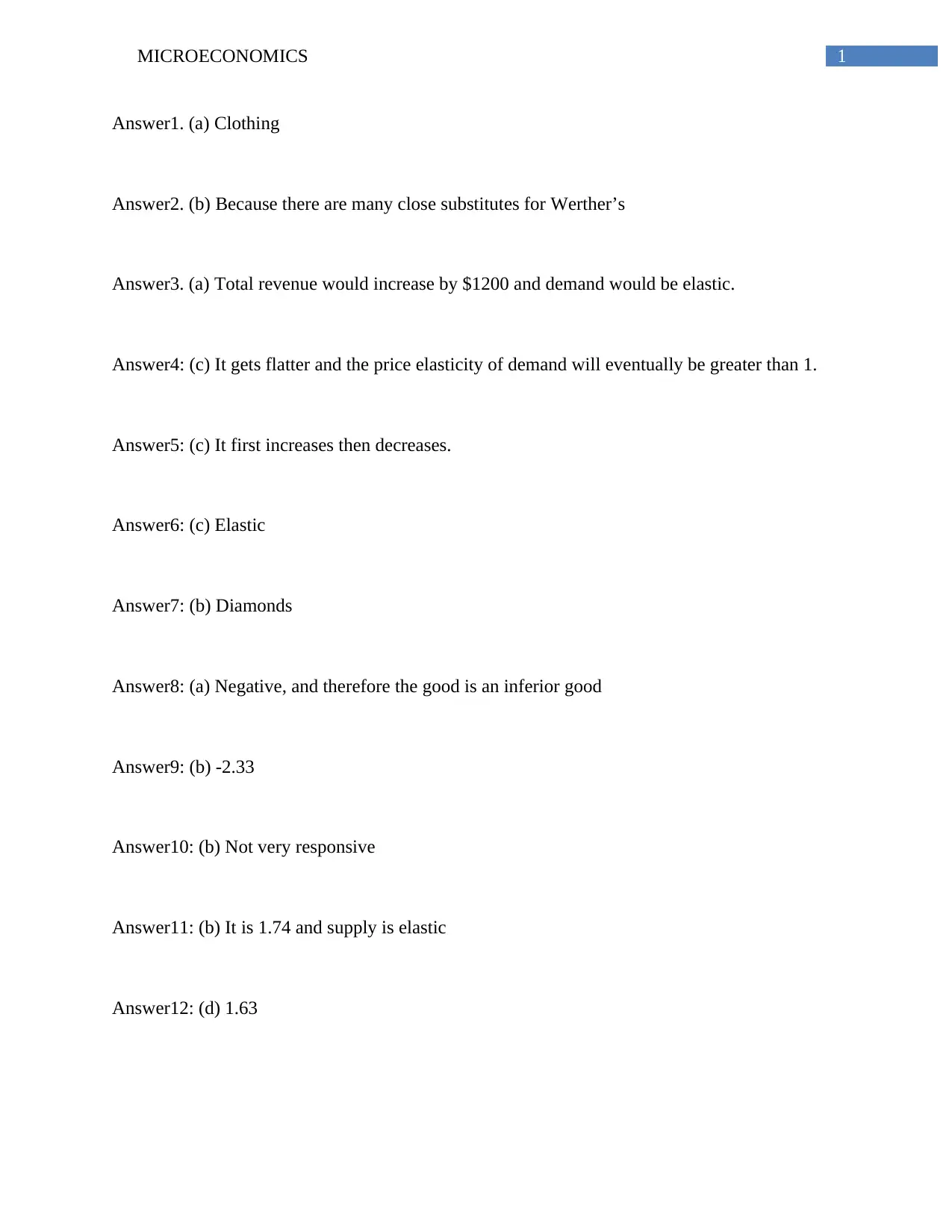
1MICROECONOMICS
Answer1. (a) Clothing
Answer2. (b) Because there are many close substitutes for Werther’s
Answer3. (a) Total revenue would increase by $1200 and demand would be elastic.
Answer4: (c) It gets flatter and the price elasticity of demand will eventually be greater than 1.
Answer5: (c) It first increases then decreases.
Answer6: (c) Elastic
Answer7: (b) Diamonds
Answer8: (a) Negative, and therefore the good is an inferior good
Answer9: (b) -2.33
Answer10: (b) Not very responsive
Answer11: (b) It is 1.74 and supply is elastic
Answer12: (d) 1.63
Answer1. (a) Clothing
Answer2. (b) Because there are many close substitutes for Werther’s
Answer3. (a) Total revenue would increase by $1200 and demand would be elastic.
Answer4: (c) It gets flatter and the price elasticity of demand will eventually be greater than 1.
Answer5: (c) It first increases then decreases.
Answer6: (c) Elastic
Answer7: (b) Diamonds
Answer8: (a) Negative, and therefore the good is an inferior good
Answer9: (b) -2.33
Answer10: (b) Not very responsive
Answer11: (b) It is 1.74 and supply is elastic
Answer12: (d) 1.63
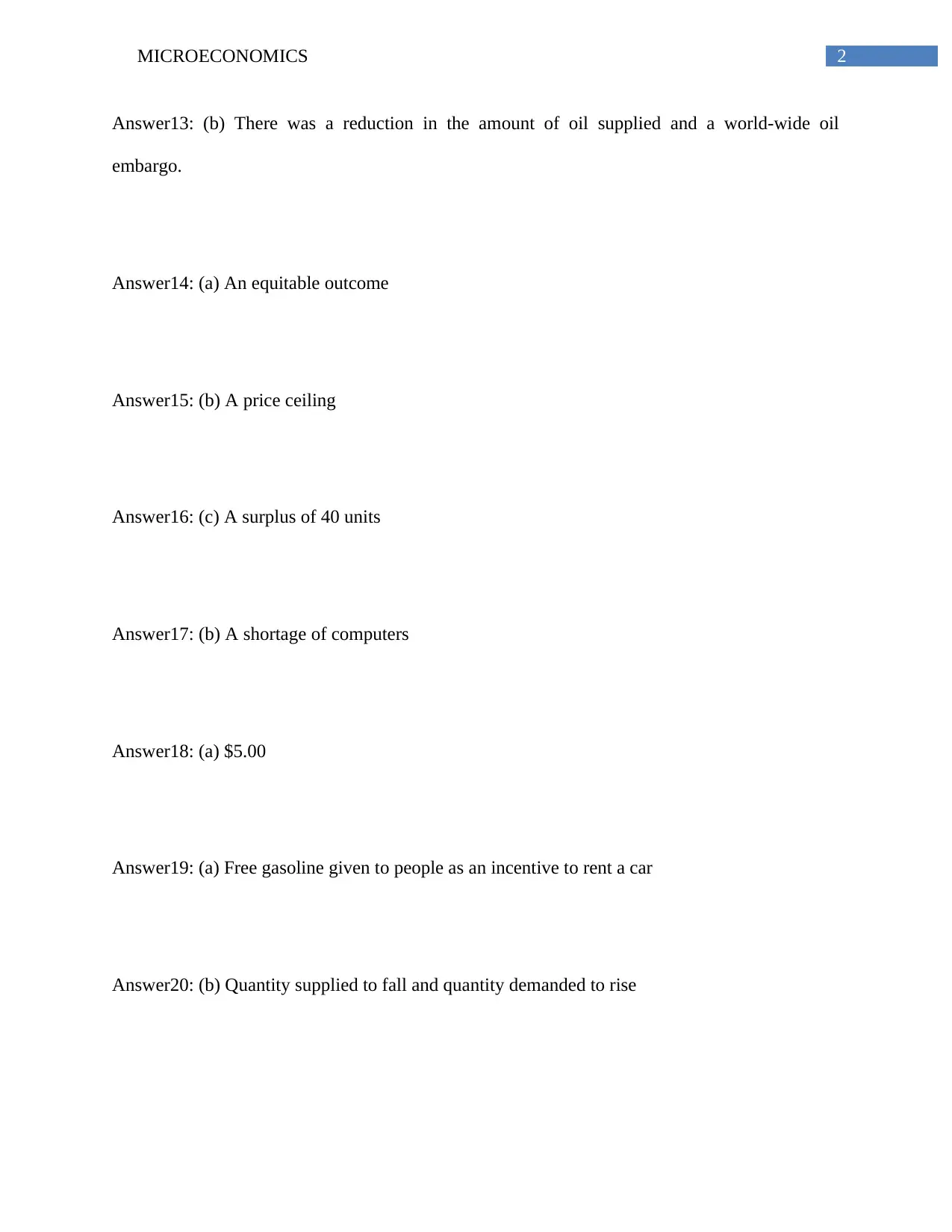
2MICROECONOMICS
Answer13: (b) There was a reduction in the amount of oil supplied and a world-wide oil
embargo.
Answer14: (a) An equitable outcome
Answer15: (b) A price ceiling
Answer16: (c) A surplus of 40 units
Answer17: (b) A shortage of computers
Answer18: (a) $5.00
Answer19: (a) Free gasoline given to people as an incentive to rent a car
Answer20: (b) Quantity supplied to fall and quantity demanded to rise
Answer13: (b) There was a reduction in the amount of oil supplied and a world-wide oil
embargo.
Answer14: (a) An equitable outcome
Answer15: (b) A price ceiling
Answer16: (c) A surplus of 40 units
Answer17: (b) A shortage of computers
Answer18: (a) $5.00
Answer19: (a) Free gasoline given to people as an incentive to rent a car
Answer20: (b) Quantity supplied to fall and quantity demanded to rise
⊘ This is a preview!⊘
Do you want full access?
Subscribe today to unlock all pages.

Trusted by 1+ million students worldwide
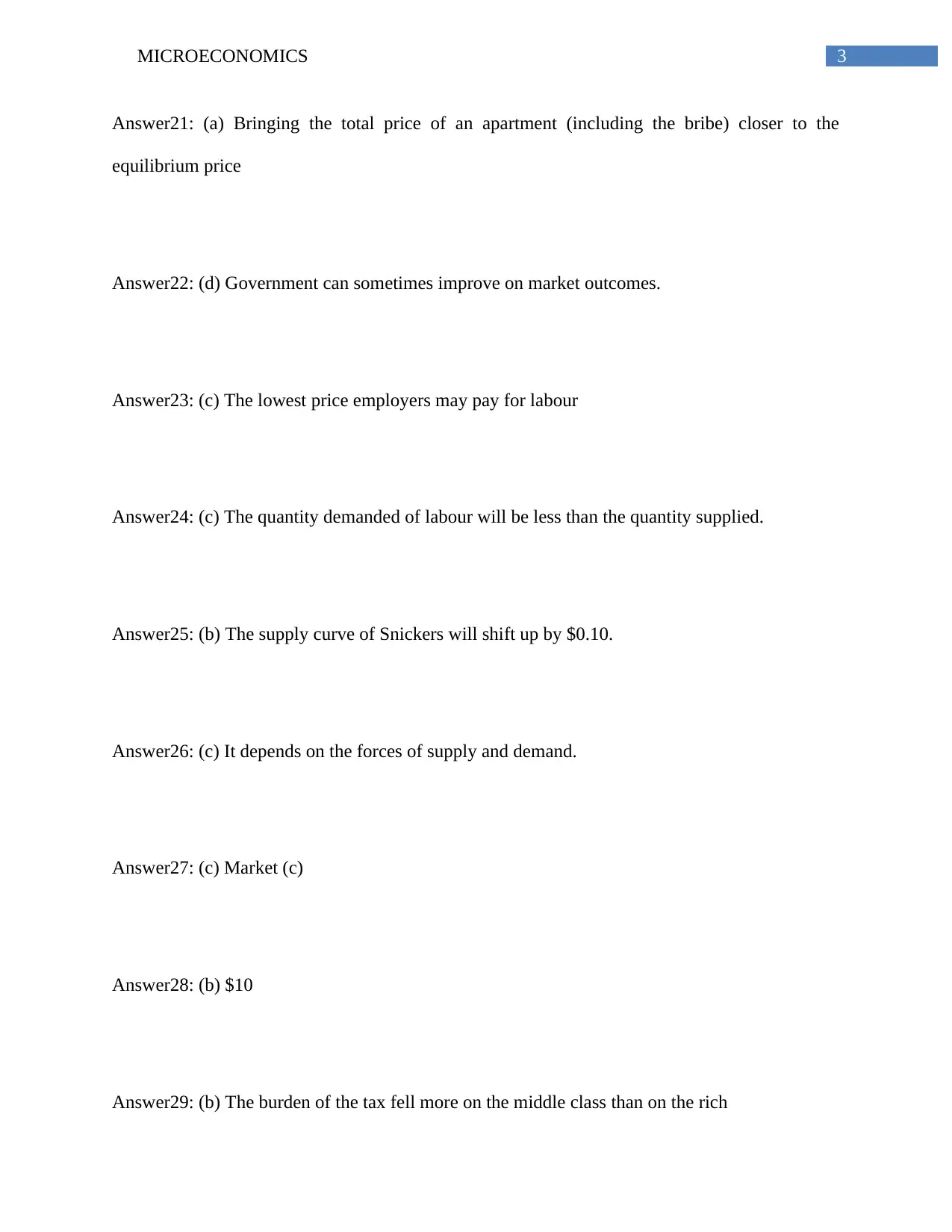
3MICROECONOMICS
Answer21: (a) Bringing the total price of an apartment (including the bribe) closer to the
equilibrium price
Answer22: (d) Government can sometimes improve on market outcomes.
Answer23: (c) The lowest price employers may pay for labour
Answer24: (c) The quantity demanded of labour will be less than the quantity supplied.
Answer25: (b) The supply curve of Snickers will shift up by $0.10.
Answer26: (c) It depends on the forces of supply and demand.
Answer27: (c) Market (c)
Answer28: (b) $10
Answer29: (b) The burden of the tax fell more on the middle class than on the rich
Answer21: (a) Bringing the total price of an apartment (including the bribe) closer to the
equilibrium price
Answer22: (d) Government can sometimes improve on market outcomes.
Answer23: (c) The lowest price employers may pay for labour
Answer24: (c) The quantity demanded of labour will be less than the quantity supplied.
Answer25: (b) The supply curve of Snickers will shift up by $0.10.
Answer26: (c) It depends on the forces of supply and demand.
Answer27: (c) Market (c)
Answer28: (b) $10
Answer29: (b) The burden of the tax fell more on the middle class than on the rich
Paraphrase This Document
Need a fresh take? Get an instant paraphrase of this document with our AI Paraphraser
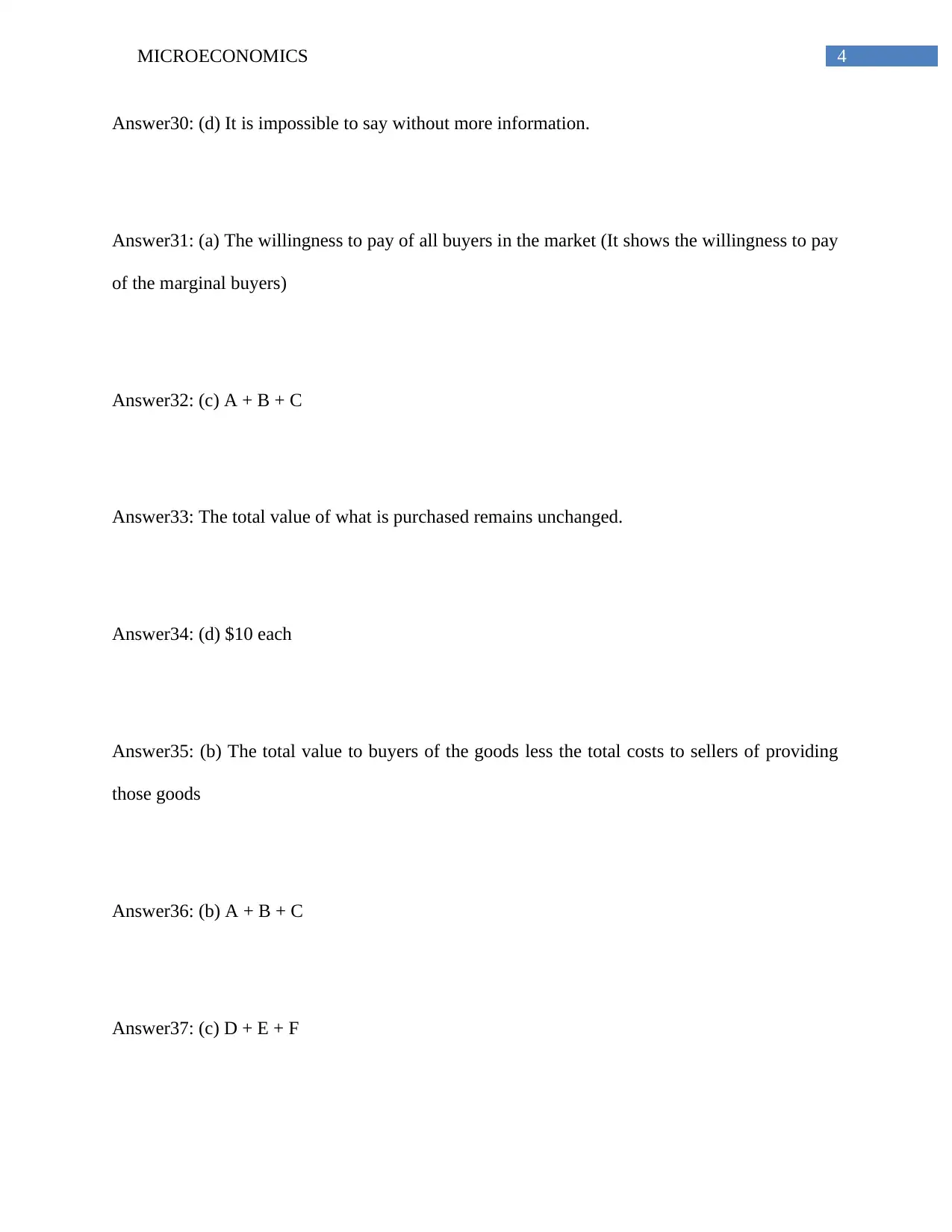
4MICROECONOMICS
Answer30: (d) It is impossible to say without more information.
Answer31: (a) The willingness to pay of all buyers in the market (It shows the willingness to pay
of the marginal buyers)
Answer32: (c) A + B + C
Answer33: The total value of what is purchased remains unchanged.
Answer34: (d) $10 each
Answer35: (b) The total value to buyers of the goods less the total costs to sellers of providing
those goods
Answer36: (b) A + B + C
Answer37: (c) D + E + F
Answer30: (d) It is impossible to say without more information.
Answer31: (a) The willingness to pay of all buyers in the market (It shows the willingness to pay
of the marginal buyers)
Answer32: (c) A + B + C
Answer33: The total value of what is purchased remains unchanged.
Answer34: (d) $10 each
Answer35: (b) The total value to buyers of the goods less the total costs to sellers of providing
those goods
Answer36: (b) A + B + C
Answer37: (c) D + E + F
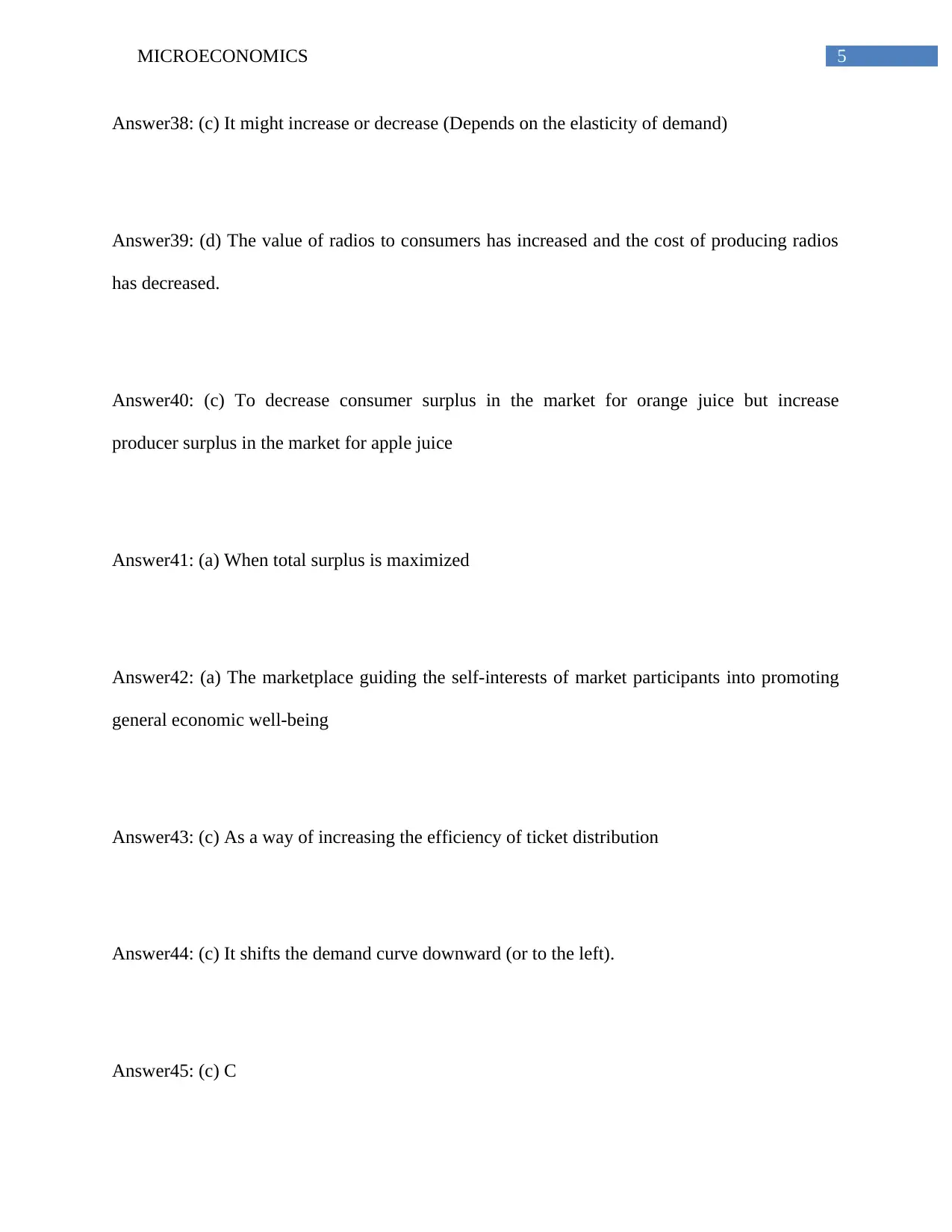
5MICROECONOMICS
Answer38: (c) It might increase or decrease (Depends on the elasticity of demand)
Answer39: (d) The value of radios to consumers has increased and the cost of producing radios
has decreased.
Answer40: (c) To decrease consumer surplus in the market for orange juice but increase
producer surplus in the market for apple juice
Answer41: (a) When total surplus is maximized
Answer42: (a) The marketplace guiding the self-interests of market participants into promoting
general economic well-being
Answer43: (c) As a way of increasing the efficiency of ticket distribution
Answer44: (c) It shifts the demand curve downward (or to the left).
Answer45: (c) C
Answer38: (c) It might increase or decrease (Depends on the elasticity of demand)
Answer39: (d) The value of radios to consumers has increased and the cost of producing radios
has decreased.
Answer40: (c) To decrease consumer surplus in the market for orange juice but increase
producer surplus in the market for apple juice
Answer41: (a) When total surplus is maximized
Answer42: (a) The marketplace guiding the self-interests of market participants into promoting
general economic well-being
Answer43: (c) As a way of increasing the efficiency of ticket distribution
Answer44: (c) It shifts the demand curve downward (or to the left).
Answer45: (c) C
⊘ This is a preview!⊘
Do you want full access?
Subscribe today to unlock all pages.

Trusted by 1+ million students worldwide
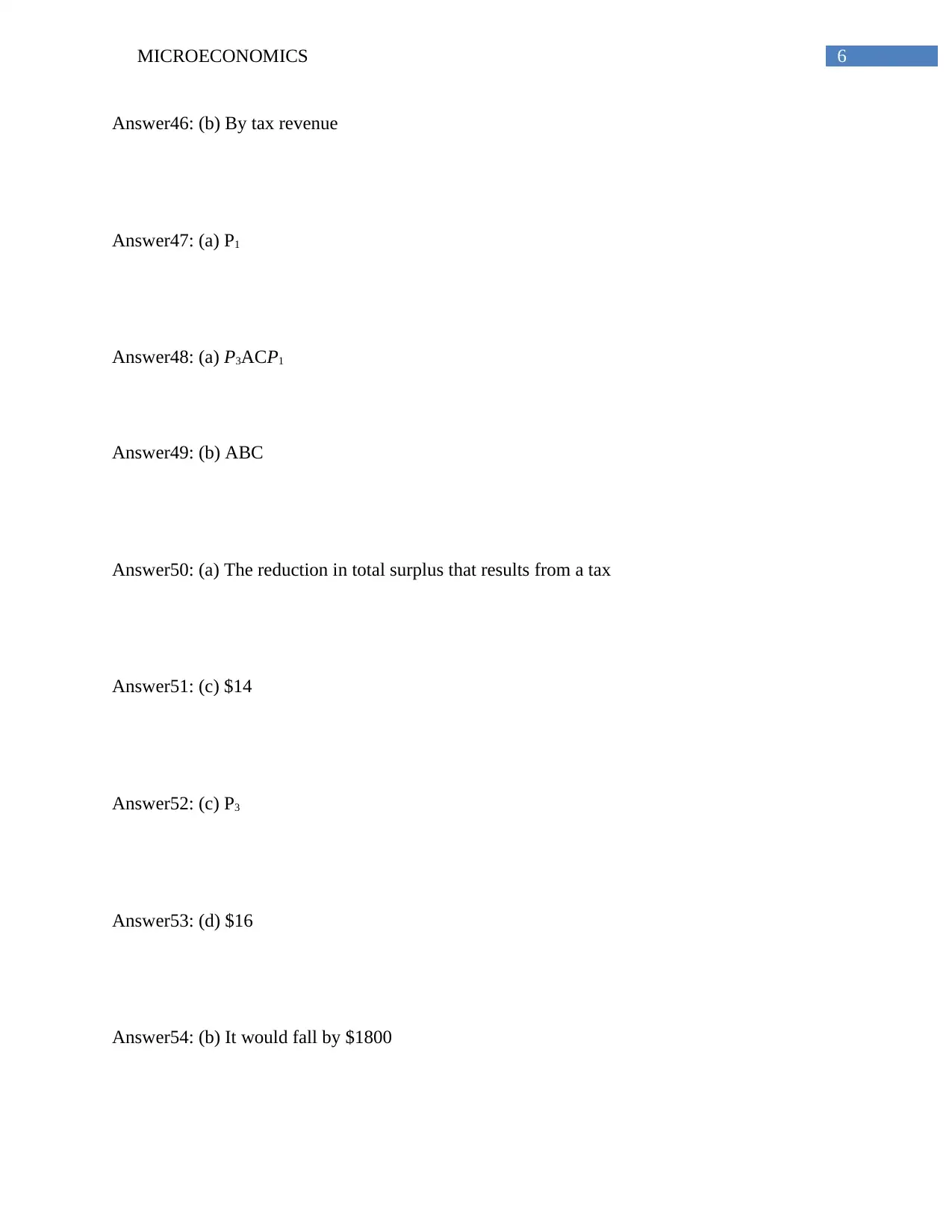
6MICROECONOMICS
Answer46: (b) By tax revenue
Answer47: (a) P1
Answer48: (a) P3ACP1
Answer49: (b) ABC
Answer50: (a) The reduction in total surplus that results from a tax
Answer51: (c) $14
Answer52: (c) P3
Answer53: (d) $16
Answer54: (b) It would fall by $1800
Answer46: (b) By tax revenue
Answer47: (a) P1
Answer48: (a) P3ACP1
Answer49: (b) ABC
Answer50: (a) The reduction in total surplus that results from a tax
Answer51: (c) $14
Answer52: (c) P3
Answer53: (d) $16
Answer54: (b) It would fall by $1800
Paraphrase This Document
Need a fresh take? Get an instant paraphrase of this document with our AI Paraphraser
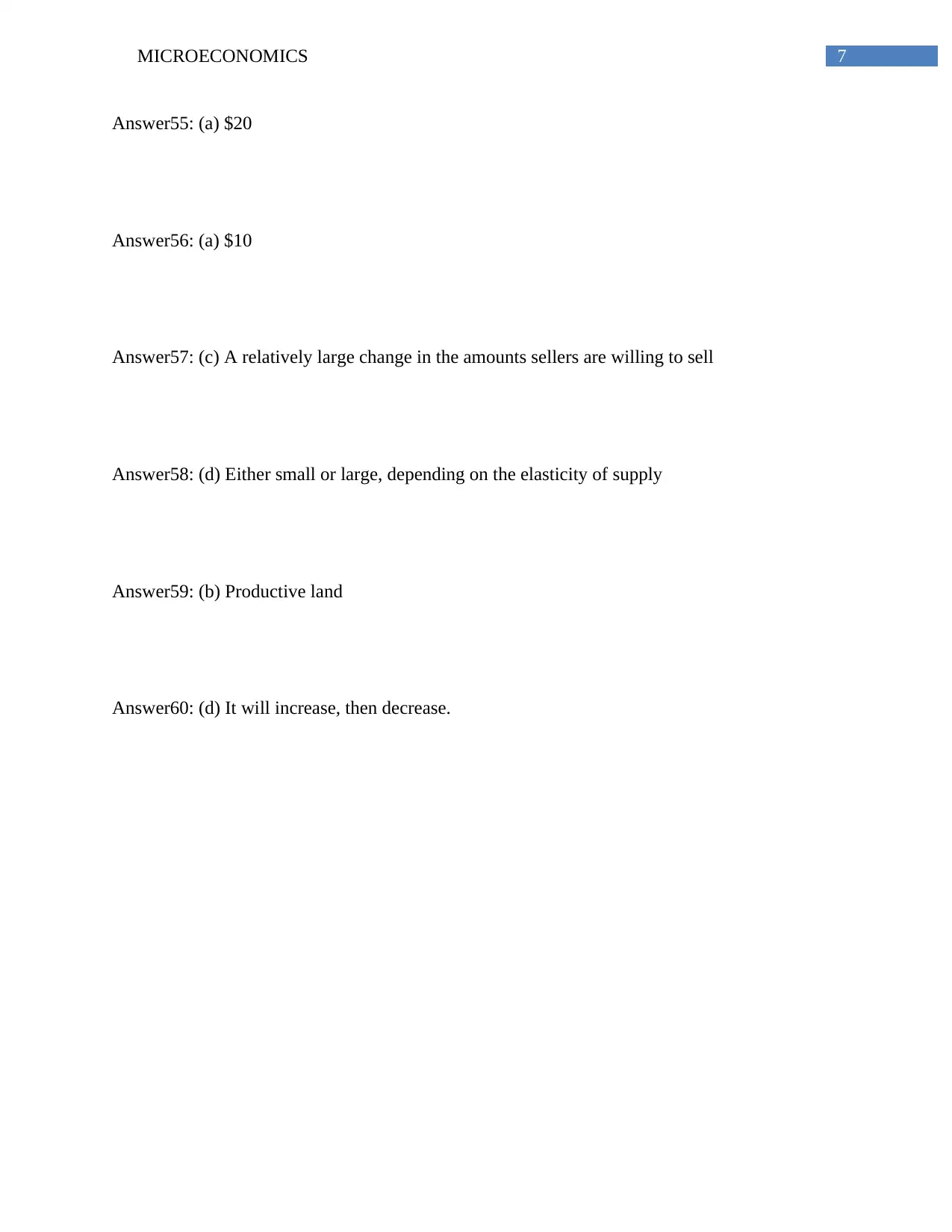
7MICROECONOMICS
Answer55: (a) $20
Answer56: (a) $10
Answer57: (c) A relatively large change in the amounts sellers are willing to sell
Answer58: (d) Either small or large, depending on the elasticity of supply
Answer59: (b) Productive land
Answer60: (d) It will increase, then decrease.
Answer55: (a) $20
Answer56: (a) $10
Answer57: (c) A relatively large change in the amounts sellers are willing to sell
Answer58: (d) Either small or large, depending on the elasticity of supply
Answer59: (b) Productive land
Answer60: (d) It will increase, then decrease.
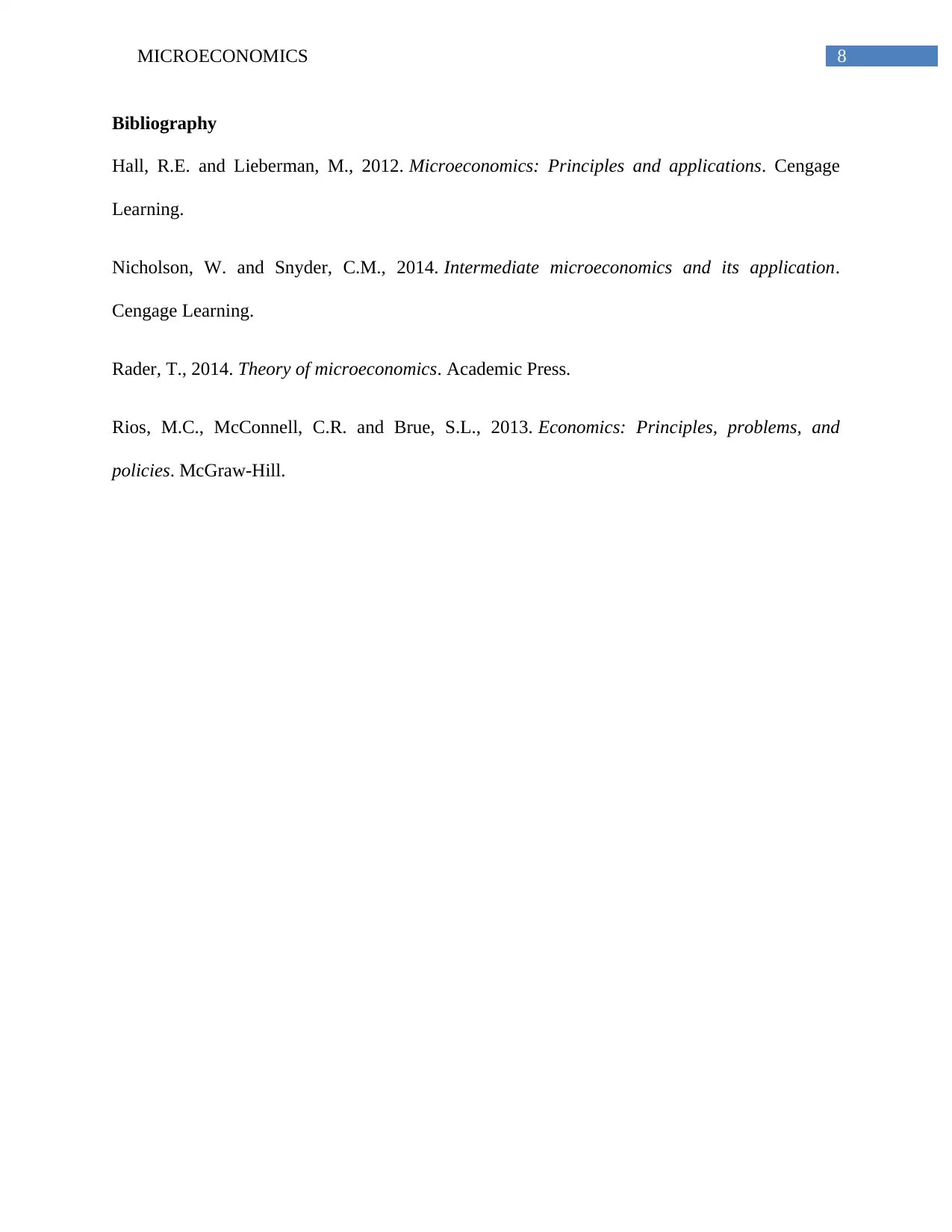
8MICROECONOMICS
Bibliography
Hall, R.E. and Lieberman, M., 2012. Microeconomics: Principles and applications. Cengage
Learning.
Nicholson, W. and Snyder, C.M., 2014. Intermediate microeconomics and its application.
Cengage Learning.
Rader, T., 2014. Theory of microeconomics. Academic Press.
Rios, M.C., McConnell, C.R. and Brue, S.L., 2013. Economics: Principles, problems, and
policies. McGraw-Hill.
Bibliography
Hall, R.E. and Lieberman, M., 2012. Microeconomics: Principles and applications. Cengage
Learning.
Nicholson, W. and Snyder, C.M., 2014. Intermediate microeconomics and its application.
Cengage Learning.
Rader, T., 2014. Theory of microeconomics. Academic Press.
Rios, M.C., McConnell, C.R. and Brue, S.L., 2013. Economics: Principles, problems, and
policies. McGraw-Hill.
⊘ This is a preview!⊘
Do you want full access?
Subscribe today to unlock all pages.

Trusted by 1+ million students worldwide

9MICROECONOMICS
1 out of 10
Related Documents
Your All-in-One AI-Powered Toolkit for Academic Success.
+13062052269
info@desklib.com
Available 24*7 on WhatsApp / Email
![[object Object]](/_next/static/media/star-bottom.7253800d.svg)
Unlock your academic potential
Copyright © 2020–2025 A2Z Services. All Rights Reserved. Developed and managed by ZUCOL.





